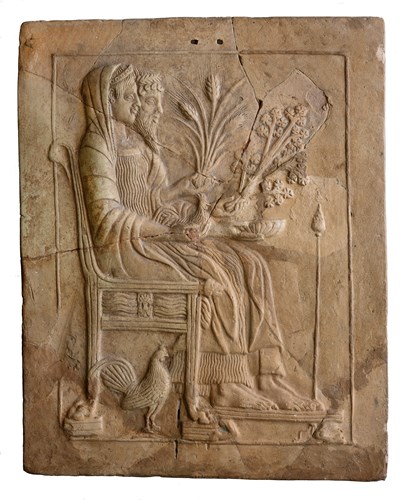The deiknymena were the sacred objects revealed by the hierophant to the mystai at the culmination of the celebration. Our knowledge of their nature is inversely proportional to their significance and approaches absolute ignorance. The objects remained in the Anaktoron throughout the year. Only the hierophant had the right to enter this sanctuary and handle them. During the celebration of the Greater Mysteries, the sacred objects were transported to Athens in cysts and returned to Eleusis with the grand procession on the 19th of Boedromion. The following night, the hierophant entered the Anaktoron, took the objects, and revealed them to the thousands of mystai seated in the Telesterion in an eerie and bright light that caused awe and admiration.
The Christian writers who dealt with the Eleusinian Mysteries offer a wealth of information about the symbols and objects of worship. Clement of Alexandria (150-211) refers to a phallus that supposedly remained in the cyst for the mystai to touch without seeing it, a proposition that contradicts the general assumption that the hierophant showed the sacred objects to the faithful. Other items mentioned include sesame bread, pyramidal and spherical cakes, pomegranates, coarse salt, a snake, fig branches, fennel stalks, ivy, poppies, a lamp, a sword, oregano, and a female comb. It is a patchwork of objects from various mystical cults that has nothing to do with the Eleusinian Mysteries.
Hippolytus of Rome (170-235) argues that the omnipotent, wonderful, and perfect supervisory mystery that the hierophant showed to the mystai in the bright light was a single harvested head of grain. However, we must reject this argument due to the frequent depiction of grain in sculptures and architectural elements outside the sacred precinct (where they were obviously visible to uninitiated passers-by).

Pinax of Persephone and Hades on the throne, sculpture, Museo Archeologico Nazionale di Reggio Calabria © Su concessione del Ministero della cultura n.79 del 25/10/2022 - Museo Archeologico Nazionale di Reggio Calabria.
It also seems unlikely that the sacred objects were statues of deities. The inscription on the votive relief of Rheitoi concerning the construction of a bridge on the Sacred Way in the area of the lakes refers to the transport of sacred objects by the priestesses. The priestesses were forced to cross the bridge on foot because the width of the deck did not allow carriages to pass. The revered priestesses of Demeter and Persephone would not be able to carry in their hands full-length bronze or statues, even for a relatively short distance. The sacred objects had to remain inside the cysts, away from the eyes of the uninitiated, so they had to be small in size. Another theory claims that the cysts contained remains of the Mycenaean era with an unusual appearance, whose antiquity gave the impression that the goddess Demeter herself could have used them.





